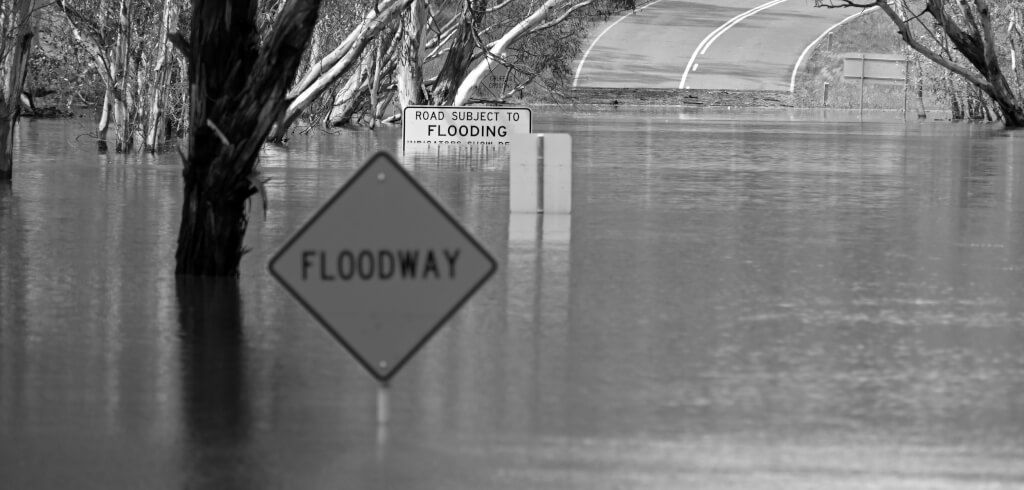Americans are moving out of flood-prone areas in droves, a migration scientists call a 'death spiral'
The increasing risk of flooding is accelerating the relocation of Americans from hazardous counties across the United States. This could lead to mass migration of historic proportions, reports The Hill.

Photo: IStock
According to conclusions, published in the journal Nature Climate Change, these abandoned areas tend to represent regions of historical disinvestment, and flight from them is accelerating.
In cities across the country, but especially in Midwestern states such as Indiana, Ohio, Michigan and Minnesota, the growing risk of flooding has led to accelerated relocation. In areas most threatened by climate change, only those who cannot afford to leave will remain.
Unless investments are made to adapt these areas to better withstand environmental threats, “major migrations on the same scale as the Great Migration in the twentieth century, which displaced 4 million people,” are likely to occur, the authors write.
Areas in many cities such as Houston, Miami and Washington, D.C., are among the places people are fleeing due to the growing risk of flooding.
But while these cities are still attracting people faster than flood risk is driving them out, the study shows that many are approaching a tipping point before they begin to decline.
People fleeing floods
New research on the impact of flood risk on migration comes from the First Street Foundation, a nonprofit research group that makes long-term climate risk projections for individual properties across the United States.
The data shows that climate change is no longer “a thing that can affect my kids,” as First Street founder Matthew Eby said.
“The valuation of my property is changing now,” he says.
But the success of the tools First Street created to track those risks presented its team with a paradox, said Jeremy Porter, First Street's climate impact lead and a professor at the City University of New York.
Porter said one common narrative about America's response to climate change is that people are "moving back toward risk," leaving the Midwest and Northeast for the heat- and flood-prone Southern states and the fire-prone West.
As for flood-related residential changes, Porter said the First Street study backed that up — at least when it comes to interstate moves.
When First Street's tools were integrated into real estate sites Redfin and Zillow, it became clear that people were actually taking climate into account when deciding where to buy, Porter said.
And these long-distance moves are only a small part of the story, since most moves are local. About four times as many Americans drive within their own county than cross state lines, Porter said.
By studying the impact of rising flood risk on the population of approximately 8 million individual neighborhoods—parts of neighborhoods that are often home to just a few dozen people—Porter's team found that when it comes to more common short-term moves, people tend to move away from flood risk. and not approach him.
These findings represent only a small part of the broader picture of climate risks. First Street is releasing a more comprehensive model early next year to track the impact of all climate risks on migration - including heat, fires, smoke and wind.
The findings show that flood risk alone is already driving population out-migration from about 3 million sites across the country, home to about a third of the U.S. population. According to the study, these neighborhoods have lost about 20 million people over the past 9 years, about 3 million of them as a result of increased flood risk. This type of neighborhood in decline is what the First Street team calls “climate abandonment zones”—parts of neighborhoods where more people moved out than moved in between 2000 and 2020.
In most cases, this reduction is on the order of 10 percent. But in the most extreme cases—such as the Midland Beach area of Staten Island—the population decline was more like a collapse.
First Street found that the population of 93 in 2000 had dropped by two-thirds to 2020 by 31.
Such a dramatic collapse could trigger a death spiral, said Public Citizen's Anne Perrault.
"Death Spiral"
In many regions, the outflow of population leaves behind devastated neighborhoods. This, in the most extreme cases, leads to abandoned areas becoming more and more abandoned, Perrault explained.
As the spiral widens, Perreault said, "people will continue to move out of vulnerable areas, while those areas will expand due to increased global warming." This population decline and property abandonment, in turn, makes it difficult for cities to obtain municipal loans to clean up their mess. This all creates a self-reinforcing emigration model.
The Financial Stability Oversight Council reiterated concerns about such patterns in its report released Dec. 14. The report found that planetary warming “has significant costs for people and economies, with the economic costs of climate change expected to rise.”
This report highlights the dangers of death spirals of displacement spreading across the country. When insurance companies pull out of climate-risk areas, it sets off a cycle of declining home values, resulting in fewer new loans being issued to buy, build or renovate local homes.
The areas currently losing people are only part of an evolving story of loss and growth. The Nature study identified 513 counties—or nearly 20 percent of the continental U.S.—that were growing faster than the national average but contained blighted neighborhoods.
Although the population in many of these flood-prone counties is growing, people are moving there at a slower rate than comparable areas without the risk of flooding: such areas attract about 4 million fewer people than similar areas that do not face such risk.
You may be interested in: top New York news, stories of our immigrants, and helpful tips about life in the Big Apple - read all this on ForumDaily New York.
These areas are scattered throughout the United States, but they are particularly concentrated along the Gulf Coast (especially Houston and virtually all of Florida) and the mid-Atlantic between New Jersey and Washington, DC.
For example, metropolitan areas such as Houston, Fort Worth, Phoenix, El Paso, and the Jersey Shore experienced growth of 2000 to 2040 percent between 20 and 40, while 10 to 20 percent of census tracts in These districts lost people.
Collectively, these areas of increased growth and increasing risk will reach a tipping point starting in 2025, after which they will begin to decline, ultimately losing around 5 million people due to flood risk alone. The model predicts that over the next 30 years, these new “climate abandonments” will continue to spread—and be joined by nearly half a million more such deteriorating areas.
In many of the nation's most populous counties, 2053 to more than 20 percent of the area will be in decline by 50, according to the model.
By mid-century, about 55 percent of the counties that make up Minneapolis are projected to lose people, about 45 percent to Milwaukee County, 30 percent to Providence County and a quarter to the D.C. suburb of Alexandria.
In contrast, the model predicts that some urban counties will experience increased migration due to decreased risk. For example, in counties in the metropolitan areas that include Newark, Detroit, Boulder, San Francisco and Chicago.
The Downside of Migration
First Street's data also revealed a troubling trend for cities overall. While migration to newer, less flood-prone developments has reduced the risk of flooding for individuals, evidence suggests it likely increases the risk for cities as a whole.
Take San Antonio, Texas, for example, a fast-growing metropolitan area where First Street data shows 18 percent of census blocks are losing people due to flood risk, even though the county as a whole has seen a 44 percent increase in population.
The city is moving people from an increasingly flood-prone urban core—neighborhoods like Tobin Hill/Pearl, where 40 percent of neighborhoods are losing population—to new, expanding suburban developments in the hills outside the city, according to the data.
At Alamo Ranch, for example, which developers bought in the early 2000s, rapid development has filled what was once green space. While this may reduce the risks for people moving in, every new development that goes up on former bushland and livestock pastures increases the risk of flooding for everyone downstream.
That's because new developments mean huge new swaths of water-repellent asphalt and concrete on lands that once soaked up rain, Porter said. He said the addition of new “roads, houses and shopping centers will have a significant impact on the natural environment and the natural management of rainfall and river flooding.”
Porter said migration from flood-prone counties presents policymakers with a paradox, but also provides some information needed to address the problem.
The data Porter's team produces gives policymakers the tools to make real decisions: determining which regions are beyond saving due to overwhelming climate pressures, and which are vulnerable due to a long history of banks' often barbaric decisions not to invest or lend money for public infrastructure.
Territories of the second category, according to Porter, can be saved through timely investments in public infrastructure.
Without such intervention - and in some regions even with it - the flight could reach terrible proportions, he said.
“The end state of this process is where people who can afford to leave leave, and people who cannot afford to leave end up staying in the community,” Porter said.
Read also on ForumDaily:
Top 24 unexpected facts about Christmas that will definitely surprise you
Rain, floods and tornadoes: severe storm heading for Florida
Where to buy mini-homes in the USA: five companies that offer affordable small housing
Subscribe to ForumDaily on Google NewsDo you want more important and interesting news about life in the USA and immigration to America? — support us donate! Also subscribe to our page Facebook. Select the “Priority in display” option and read us first. Also, don't forget to subscribe to our РєР ° РЅР ° Р »РІ Telegram and Instagram- there is a lot of interesting things there. And join thousands of readers ForumDaily New York — there you will find a lot of interesting and positive information about life in the metropolis.












